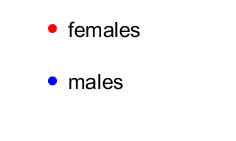Predictions & Data for this entry
| Model: abj | climate: B, C | migrate: | phylum: |
| COMPLETE = 2.3 | ecozone: THn | food: biPp, biD | class: |
| MRE = 0.025 | habitat: 0iFpe | gender: D | order: |
| SMSE = 0.001 | embryo: Fbf | reprod: Apf | family: |
Zero-variate data
| Data | Observed | Predicted | (RE) | Unit | Description | Reference |
|---|---|---|---|---|---|---|
| ab | 0.8 | 1.289 | (0.6116) | d | age at birth | guess |
| tp | 7.5 | 7.57 | (0.009391) | d | time since birth at puberty | MeadObre1995 |
| am | 25 | 25.02 | (0.0006203) | d | life span | guess |
| Lb | 0.04 | 0.09483 | (1.371) | cm | total length at birth | guess |
| Lp | 0.9 | 0.8893 | (0.01187) | cm | total length at puberty | MeadObre1995 |
| Li | 1.3 | 1.321 | (0.01653) | cm | ultimate total length | MeadObre1995 |
| Wwb | 9.2e-06 | 8.838e-06 | (0.03936) | g | wet weight at birth | Belk1977 |
| Wdi | 0.0037 | 0.004065 | (0.09877) | g | ultimate dry weight | guess |
| Ri | 100 | 90.17 | (0.0983) | #/d | maximum reprod rate | guess |
| sM | 5 | 5.459 | (0.09181) | - | acceleration factor | guess |
Uni- and bivariate data
| Data | Figure | Independent variable | Dependent variable | (RE) | Reference |
|---|---|---|---|---|---|
| tL_fm |   | time since birth | length | (0.01123) | MeadObre1995 |
Pseudo-data at Tref = 20°C
| Data | Generalised animal | Branchinecta lindahli | Unit | Description |
|---|---|---|---|---|
| v | 0.02 | 0.0363 | cm/d | energy conductance |
| p_M | 18 | 7330 | J/d.cm^3 | vol-spec som maint |
| k_J | 0.002 | 0.002 | 1/d | maturity maint rate coefficient |
| k | 0.3 | 0.00121 | - | maintenance ratio |
| kap | 0.8 | 0.9339 | - | allocation fraction to soma |
| kap_G | 0.8 | 0.8018 | - | growth efficiency |
| kap_R | 0.95 | 0.95 | - | reproduction efficiency |
Discussion
- males are supposed to differ from females by {p_Am} only
Bibliography